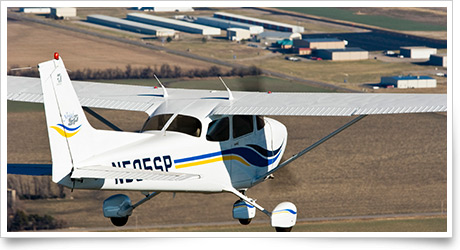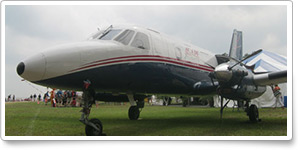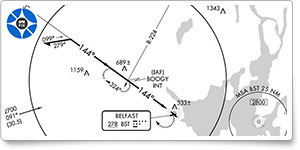Mar. 22, 2013, issue of 'AOPA ePilot: Flight Training Edition' weekly newsletter
| ||||||
| An elegant arrival |
| |||||
Training TipsAn elegant arrival
An airport doesn’t have to be blue on a sectional chart—that is, have a control tower—to have operational limitations to check on before your flight. Some of those need-to-know items may be determined by your time of arrival. Others, such as this airport’s prohibition on touch-and-go practice, are in effect at all times. (With a short runway, lots of trees on the island, and cold salt water beyond them, perhaps that’s not such an extreme constraint.)
If time of arrival isn’t a factor in how you approach your destination, what about wind? That’s easy: Between the windsock, the surface weather report, and the common traffic advisory frequency, you should have a good idea about which way to land.
What if there’s no wind?
Join the flow, or, if there is no flow at the moment, be briefed on what is expected. For example, if your destination happens to be Jesse Viertel Memorial Airport in Boonville, Mo.—home of the Daniel Boone Flying Club—you would want to know that Runway 18 is the designated calm-wind runway.
If a north wind were to come up while you are on the ground, be mindful of the noise-abatement procedure for a takeoff on Runway 36. Complying with it also will put your skill at tracking the runway’s extended centerline to a fair test.
Note also that extensive flight training is reported to take place in the area—a good reason to monitor the local frequency well before your arrival.
If that arrival takes place between 1400Z and 2000Z, the airport should be attended. Self-serve fuel is available at other times, so make sure you will be able to attend to that chore on your own. Flight Training NewsEmbry-Riddle to offer emergency water landing courseIf recent news coverage of pilots forced to ditch their aircraft has you rattled, you can train for the possibility that you might be in the same situation through a new course offered by Embry-Riddle Aeronautical University. Read more >> Air Race Classic closes in on registration goalEntries for the 2013 Air Race Classic, the longest-running all-women pilots transcontinental air race, are now at 80 percent and are expected to reach a goal of 55 teams before the April 1 deadline. This year’s event is a 2,100-nautical-mile, day-VFR race from Pasco, Wash., to Fayetteville, Ark., that will run June 18 through 21. Read more >> Apps to help prepare for private pilot exam, flight reviewAs AOPA eNewsletter and Social Media Editor Benét J. Wilson continues her personal journey as a student pilot, she’s always looking for any tip, trick, or technology that will help her in the learning process. To that end, there are myriad apps that can help do just that. Read more >> Learn photography, video techniques in the April Facebook chatDo you take photos in flight? Is a video camera a fixture in your airplane? You’ll want to join Flight Training editors Ian J. Twombly and Jill W. Tallman for the next live Facebook chat. The guest chatter will be AOPA Staff Photographer Chris Rose, who will share some of the techniques he uses to bring you the great photography and videos in AOPA’s magazines and on its website. Join Rose and the editors at 3 p.m. on April 2. Visit the Flight Training Facebook page and click the Chat icon to set an email reminder and view transcripts of previous chats. Build A Plane, GAMA launch STEM competitionBuild A Plane has partnered with the General Aviation Manufacturers Association (GAMA) on a new effort to promote science, technology, engineering, and mathematics (STEM) education and stimulate student interaction in aviation and manufacturing with a nationwide competition. Eight students from across the country will win free trips to Arlington, Wash., the home of Glasair, to build two Sportsman aircraft. The finished aircraft will be on display at EAA AirVenture 2013. Read more >> More than just hot airWith the arrival of the end of winter, warmer temperatures and changing humidity will affect the areas where you live and fly, and beyond. You may know and accept this, but do you understand why? Boost your weather knowledge by taking the Air Safety Institute’s Weather Wise: Air Masses and Fronts online course. Take the course >> Topping windswept heights with easy graceThe Hitchhiker’s Guide to the Galaxy notes that the knack to flying “lies in learning how to throw yourself at the ground and miss.” The forces that allow a pilot to miss, safely and reliably, are called aerodynamics. Learn more about the fundamentals, and discover great resources to learn more about this subject by visiting the Air Safety Institute’s Aerodynamics Safety Spotlight. Read more >> Training ResourcesFor information on anything from arthritis to vision issues, or for a list of aviation medical examiners or pertinent medical websites, go to AOPA Online for subject reports on medical certification and other health-related topics.
Did you know that student pilots who join AOPA are three times more likely to complete their flight training? Membership includes unlimited access to aviation information by phone (800/USA-AOPA, weekdays from 8:30 a.m. to 8 p.m. Eastern time) or from Flight Training Online or AOPA Online. If you’re not already a member, join today and get the pilot’s edge. Login information is available online. Highlights from AOPA LiveFind out how pilots with fire emergencies can use the Emergency Vision Assurance System, which displaces smoke in the cockpit and allows for a clear view. AOPA has a new strategic partner. Find out who it is and how you benefit. And in this week’s “License to Learn,” Rod Machado shows pilots how to fly coordinated. Career PilotUS Airways flight attendants ratify contractUS Airways and its flight attendants have ratified a single contract that includes double-digit pay increases, improved job protections, and better work rules. The contract unites flight attendants from US Airways and America West, which merged in 2005, under one agreement. The union said 80 percent of flight attendants participating in the election voted to ratify the new deal. CitationAir pilots dislike new schedulesCharter aircraft provider CitationAir is being chastised by the Teamsters, which represents its 230 pilots, over radically altered work schedules that went into effect March 1. The union and CitationAir management have been negotiating a first contract for the pilots since November 2011. Prior to the change, CitationAir scheduled pilots to be available for duty seven consecutive workdays during each two-week period; now they must be available eight consecutive workdays during each two-week period—an increase of 26 workdays per year. New professional pilot program unveiledPennsylvania's Venango College of Clarion University is now offering an associate of applied science in industrial technology degree program, reports the Titusville Herald . The program was created to be a path to becoming a professional commercial pilot. Students can participate in the online program while accruing flight time. Free career fair in Fort WorthYoung pilots looking for a career in aviation are invited to a free career conference on March 23 in Fort Worth, Texas. The session, which was organized by FAPA.aero and sponsored by US Aviation Academy, is at Higher Power Aviation. Read more >> For more aviation career news, see the Flight Training website. Plane SpotterEmbraer 110 Bandeirante: ‘Bandit’ at 12 o’clock Training ProductsOnline course teaches VFR cross-countriesThe King Schools is offering an online course, VFR Cross-Country Flying . The course is a step-by-step guide to planning and flying a fun, safe VFR cross-country trip for seasoned and new pilots. Lessons include hidden traps to avoid, tips to keep you out of trouble, how to make navigation easy, ways to obtain and evaluate weather while en route, and a flight-tracking system. The cost is $49. Instrument test prep now on DVDAviation Supplies & Academics’ Instrument Pilot Virtual Test Prep Ground School is available on DVD. The DVD offers a comprehensive aviation ground school to prepare pilots for the FAA knowledge exams and help them become safe, competent, and confident. The software includes all the latest FAA test questions, answers, and explanations for true-to-form test practice.
Note: Products listed have not been evaluated by ePilot editors unless otherwise noted. AOPA assumes no responsibility for products or services listed or for claims or actions by manufacturers or vendors. Member BenefitsEA+ offers unexpected benefitsWhether you are already enrolled in Emergency Assistance Plus (EA+) or aren’t familiar with the program, chances are you have an idea of what it entails. EA+ is there for you in the event of an accident, with 24-hour emergency and medical assistance, but there are some other surprising benefits of enrolling in the program. Read more >>
BlogsClimb segmentsIn the airline world, there are a number of new rules, limits, and terms a pilot needs to learn. One area in which a new understanding needs to be had is in the takeoff. Gone are the days when, as a general aviation pilot, you can just eyeball the runway, the load, and the airplane, measure the wind with your thumb, and go for it. When you are flying passengers and cargo for hire, you need to be able to comply with the segmented climb. Read more >> Power-off V NEHelicopters have a power-on never exceed airspeed (V NE) that can be an aerodynamic limitation, a structural issue, or based on the onset of retreating blade stall. Some also have a power-off airspeed limitation, which will be shown on the airspeed indicator as a red/white hatched line or sometimes a blue line. During autorotation at high airspeeds it may not be possible to maintain sufficient main rotor RPM even with full down collective. Read more >> AOPA Career OpportunitiesEver dream of turning your passion for aviation into a career? We’re looking for a network support engineer; marketing manager, fundraising and acquisitions; member services representative; aviation technical specialist; staff assistant/PAC coordinator; president, AOPA Insurance Services; director, financial planning and analysis; office services supervisor; major gifts officer; and director of outreach and events. To learn more about other AOPA career opportunities, visit AOPA Online. Community
AVIATION EVENTS & WEATHER
| ||||||||||||||||||||||||||||||||||||




 Pointers were offered in the March 15
Pointers were offered in the March 15 




